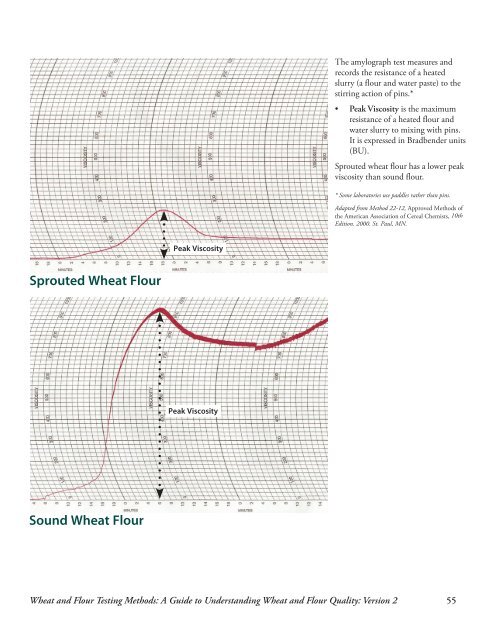Wheat and Flour Testing Methods - WHEATFLOURBOOK.ORG
Wheat and Flour Testing Methods - WHEATFLOURBOOK.ORG
Wheat and Flour Testing Methods - WHEATFLOURBOOK.ORG
Create successful ePaper yourself
Turn your PDF publications into a flip-book with our unique Google optimized e-Paper software.
Sprouted <strong>Wheat</strong> <strong>Flour</strong><br />
Sound <strong>Wheat</strong> <strong>Flour</strong><br />
Peak Viscosity<br />
Peak Viscosity<br />
<strong>Wheat</strong> <strong>and</strong> <strong>Flour</strong> <strong>Testing</strong> <strong>Methods</strong>: A Guide to Underst<strong>and</strong>ing <strong>Wheat</strong> <strong>and</strong> <strong>Flour</strong> Quality: Version 2<br />
The amylograph test measures <strong>and</strong><br />
records the resistance of a heated<br />
slurry (a flour <strong>and</strong> water paste) to the<br />
stirring action of pins.*<br />
• Peak Viscosity is the maximum<br />
resistance of a heated flour <strong>and</strong><br />
water slurry to mixing with pins.<br />
It is expressed in Bradbender units<br />
(BU).<br />
Sprouted wheat flour has a lower peak<br />
viscosity than sound flour.<br />
* Some laboratories use paddles rather than pins.<br />
Adapted from Method 22-12, Approved <strong>Methods</strong> of<br />
the American Association of Cereal Chemists, 10th<br />
Edition. 2000. St. Paul, MN.


